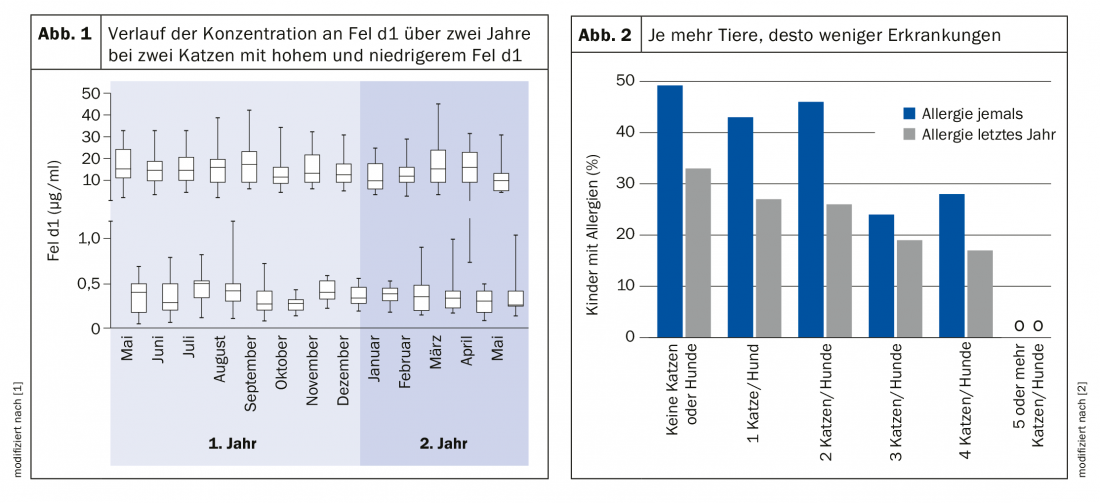Cat allergens are predominantly produced in saliva and sebaceous glands. By licking, they first get onto hair and epithelium and spread from there. Their structure allows allergens to adhere well and permanently in textiles. Once you have them in the house, they are difficult to remove. However, if you already spend your daily life with a cat as an infant, you have a good chance of never developing an allergy.
A phenomenon that many allergists know from their own experience is the statement of cat allergy sufferers, according to which symptoms regularly occur in other cats, “but I tolerate my own tiger without any problems”. Naturally behind such expressions also always the love for the own animal and the concern that the physician wants to advise against the attitude, put into perspective Professor Dr. Karl-Christian Bergmann, hospital for dermatology and Allergologie, allergy center Charité, Berlin. On the other hand, a varying allergen content from cat to cat and the different age of the animals could indeed be a possible explanation for the fact that cats trigger symptoms of varying severity.
In one study [1], saliva samples were obtained from 64 cats twice daily every 2nd day for one year at two locations (Missouri, USA, and Ontario, Canada). Saliva showed a significantly different distribution of the cat allergen Fel d1 between the different cats and during the course. Fel d1 varied from 0.4-35 μg/ml over the year, morning samples had more Fel d1 than those in the afternoon (p<0.001), and sex, hair color, and height did not correlate with Fel d1. Older cats tended to have lower values (Fig. 1).
Obviously, there are many ways to influence the “allergenicity of a cat”, i.e. the strength of allergen exposure from it. One more reason, according to Prof. Bergmann, to believe patients when they claim to have fewer complaints with their own pet.
Prof. Bergmann’s recommendations on the practical approachCase 1: Clinically silent sensitization Case 2: Clinically current sensitization |
Are cats and dogs useful in the 1st year of life?
Already in 2018, it was reported that cats and dogs in the home during the 1st year of life increase the risk of developing allergy by the 7th-8th year of life. significantly reduce the number of years of life [2]. The more animals the better, the fewer children then had sensitization or allergy at age 7 or 8!
A cohort of 1029 children aged 7 and 8 years showed that children had less asthma, allergic rhinitis, and eczema with increasing numbers of cats and dogs in the household during the 1st year of life. The curve ranged from 49% occurrence of allergy without cat and/or dog to 0% with 5 or more animals (p<0.038), and from 32% to 0% for allergy in the past year (p<0.006). Sensitization to animals and pollen also decreased as the number of animals in the home increased (Fig. 2).
The same study has now been done again, but not with such young children, but with teenagers aged 13. Again, the premise is: Does contact with a cat or dog in the 1st year of life and thereafter reduce the risk of having an allergy to these animals by age 13? And what about hay fever?

Thus, the study [3] tested what risk children 13 years of age had for developing cat and dog allergy from domestic contact with the animals during and after 1 year of age. All children (n=1231) born between 2/1996 and 1/1997 at Östersund Hospital (Sweden) were included in the study. The diagnosis of dog or cat allergy, hay fever, and asthma was determined by a questionnaire administered to the parents of 13-year-olds (n=834).
The results showed that keeping dogs or cats during the 1st year of life decreases the risk of sensitization to these animals, but also to birch pollen or at least one of 10 allergens tested. Having a cat during and after the 1st year of life decreases the risk of cat allergy and hay fever. However, acquiring a dog after the age of 1 no longer brings any benefit: the risk of dog and/or cat allergy is then no longer lower. “So if dog – at least according to this study – then better right in the first year of life,” Prof. Bergmann concludes. Dog ownership in the 1st year of life also reduced the risk of sensitization to dogs and cats, but not the development of hay fever, according to the study.
Source: Allergo-Update Berlin (D)
Literature:
- Bastien BC, et al: J Feline Med Surg 2019 Oct; 21(10): 867-874.
- Hesselmar B, et al: PLoS One 2018 Dec19; 13(12): e0208472.
- Al-Tamprouri C, et al: Immune Inflamm Dis 2019; 7: 250-257.
InFo PNEUMOLOGY & ALLERGOLOGY 2020; 2(1): 24-25 (published 3/27/20, ahead of print).
FAMILY PRACTICE 2020; 15(6): 44-45











